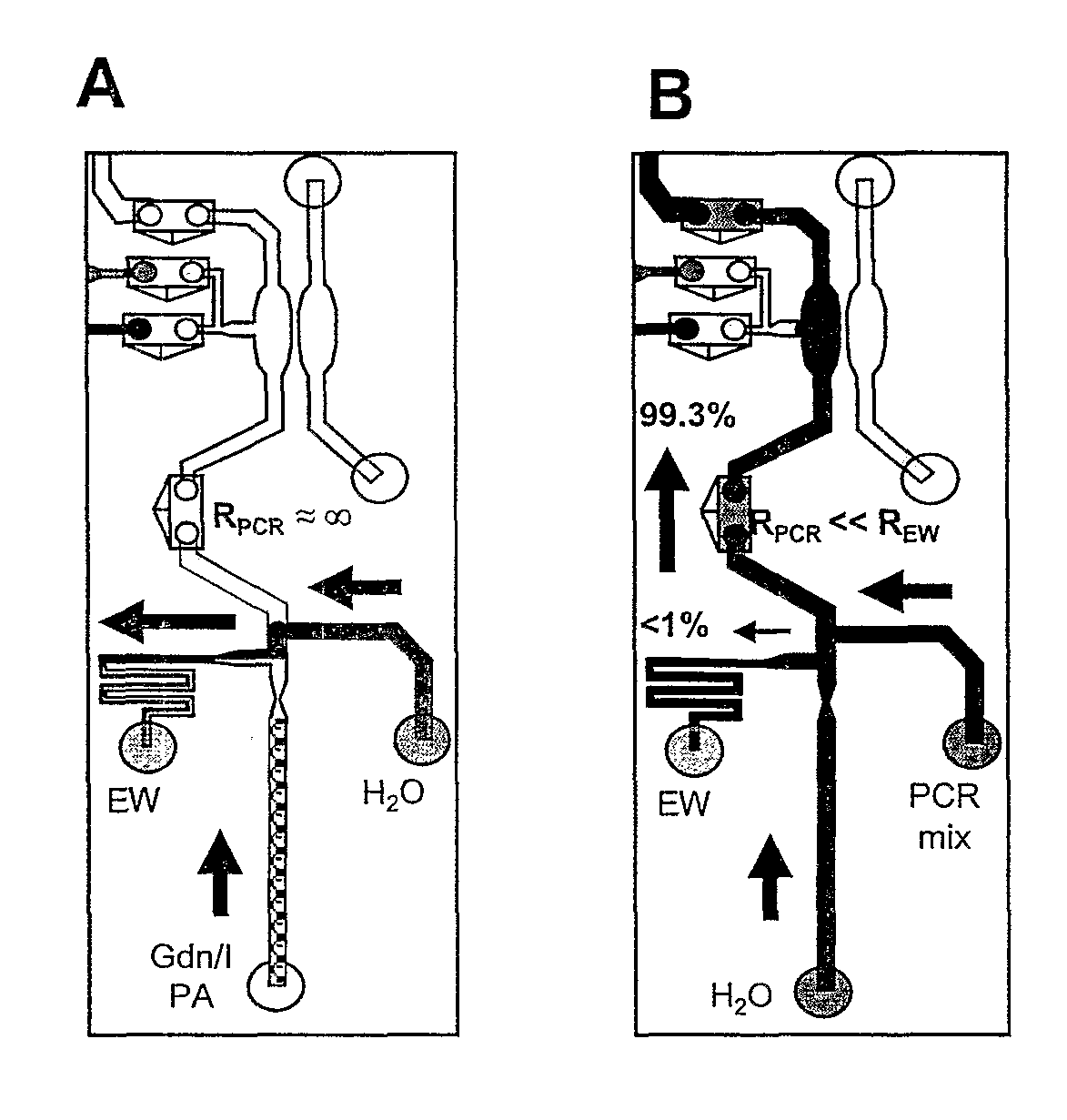Integrated microfluidic analysis systems
a microfluidic analysis and integrated technology, applied in the direction of liquid/fluent solid measurement, biomass after-treatment, peptides, etc., can solve the problems of affecting the reaction itself, affecting the reaction, and requiring 1-3 h per amplification
- Summary
- Abstract
- Description
- Claims
- Application Information
AI Technical Summary
Benefits of technology
Problems solved by technology
Method used
Image
Examples
example 1
[0050]Microchip Fabrication and Device Dimensions.
[0051]A microfluidic genetic analysis (MGE) device was made in accordance with FIGS. 2-4. The system had a microchannel architecture with three distinct functional domains—two for sample preparation (solid phase extraction (SPE), PCR) and one for electrophoretic analysis (ME). A total of five elastomeric, normally-closed valves (5) directed flow from a single syringe pump and localize the chemistries and reaction conditions that exist (FIG. 3).
[0052]All glass microchips were fabricated as previously described (Manz et al., Trends Anal. Chem., 1991, 10:144-149, which is incorporated herein by reference) utilizing standard photolithography, wet etching, and thermal bonding (640° C., 6 h). Borofloat glass slides (127 mm×127 mm×0.7 mm) were purchased from Telic (Valencia, Calif., USA), pre-coated with chrome and positive photoresist (AZ1500 resist, 5300 Å). Differential etch depths (using a buffered HF solution) were ...
example 2
Flow Control
[0077]The MGA device was tested to ensure contamination-free integration of SPE and PCR. Since the SPE process is not monitored on-line, chromatographic timing was established off-line. Fractions (1.5 μL) were collected from the SPE bed outlet during extraction and evaluated for nucleic acids by fluorescence or for PCR-amplifiable DNA by quantitative PCR (qPCR). A fluorescence assay was used to determine the timing needed for valve V1 opening to allow eluted nucleic acids to be transferred to the PCR chamber, however, qPCR revealed that the fractions with the largest mass of DNA did not contain the most PCR-amplifiable DNA. This trend was likely the result of PCR inhibition due to residual isopropanol contamination. FIG. 5 detailed the qPCR analysis with replicate DNA extractions from human whole blood. The majority of DNA was eluted in 2-5 μL; and fraction 2 consistently provided the most PCR-amplifiable DNA, thereby defining the timing for valve VI. SPE capacity was de...
example 3
Detection of Bacillus antltracis
[0078]In order for a μ-TAS to have value in clinical diagnostics or forensic genetic profiling, it must be capable of accepting whole blood and generating a genetic profile, a difficult task due to the multiple PCR inhibitors associated with this starting sample. The utility of the MGA device was evaluated with blood drawn from C57BL / 6 mice injected intraperitoneally with Bacillus anthracis spores, prior to onset of symptoms. All blood samples were positive for B. anthracis colony-forming units, and all mice subsequently succumbed to infection. The blood was mixed with lysis buffer, and a volume equivalent to 750 nL of whole blood was loaded for integrated analysis (FIG. 6). The extraction was completed in less than 10 minutes and, upon capture of the purified DNA in the 550 nL PCR microchamber, amplification was invoked using infrared (IR) thermal cycling. Subsequently, a 211 base-pair fragment found on plasmid pX01 of B. anthracis was amplified in ...
PUM
| Property | Measurement | Unit |
|---|---|---|
| feature widths | aaaaa | aaaaa |
| depth | aaaaa | aaaaa |
| depth | aaaaa | aaaaa |
Abstract
Description
Claims
Application Information
 Login to View More
Login to View More - R&D
- Intellectual Property
- Life Sciences
- Materials
- Tech Scout
- Unparalleled Data Quality
- Higher Quality Content
- 60% Fewer Hallucinations
Browse by: Latest US Patents, China's latest patents, Technical Efficacy Thesaurus, Application Domain, Technology Topic, Popular Technical Reports.
© 2025 PatSnap. All rights reserved.Legal|Privacy policy|Modern Slavery Act Transparency Statement|Sitemap|About US| Contact US: help@patsnap.com



